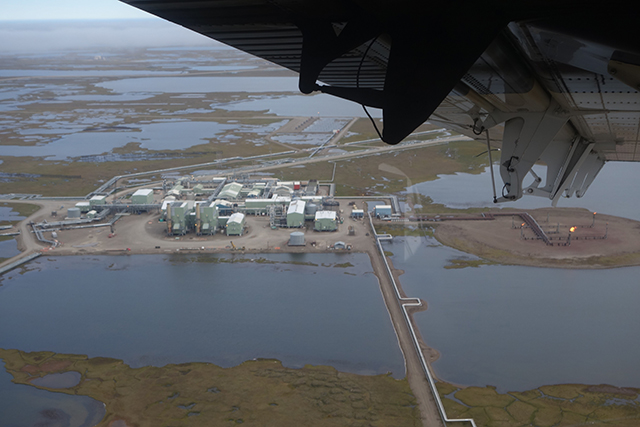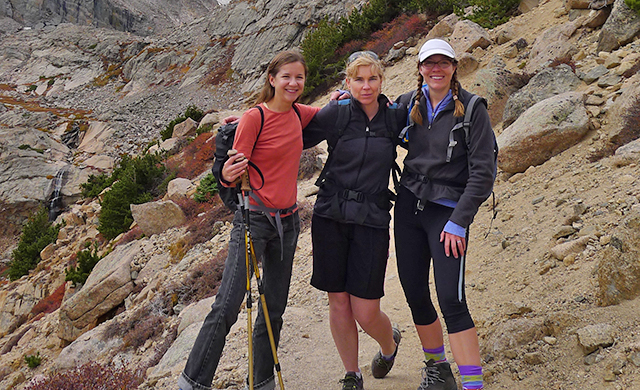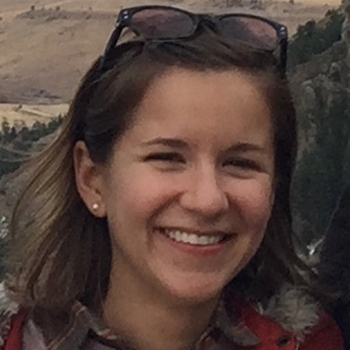Drawing scientific insights out of thin air
Every week, Kathryn McKain receives packages in the mail filled with empty flasks.
But they’re not really empty—the flasks contain air samples collected by small aircraft flying at different altitudes all over the world. As a research scientist in the Earth System Research Laboratory at the National Oceanic and Atmospheric Administration (NOAA) and the University of Colorado at Boulder, McKain, Ph.D. ’15, analyzes those air samples to measure and study greenhouse gases.
The data she and her colleagues generate is used by researchers around the world for a vast array of projects. For instance, groups studying changes in the Arctic carbon cycle might use McKain’s data in combination with atmospheric transport and vegetation models to explore the impact of anthropogenic emissions.
“It is rewarding to feel that your data could be used in ways that lead to new scientific insights,” said McKain, who earned a Ph.D. in environmental science and engineering at the Harvard John A. Paulson School of Engineering and Applied Sciences and the Graduate School of Arts and Sciences. “It is nice to be creative on a daily basis and pursue the questions that pique your own interest. What do I think are the problems that are most pressing to society, and how do we provide information to solve those problems?”

McKain and two colleagues install instruments on a DC-8 aircraft for the NASA Atmospheric Tomography (ATom) project, which seeks to understand how short-lived greenhouse gases like ozone and methane contribute to climate change. (Photo provided by Kathryn McKain)
It’s a fitting role for someone who has always had an interest in preserving the environment.
A biology major at Mount Holyoke College, McKain fell is love with ecology during a summer project at the Harvard Forest. Through the Research Experiences for Undergraduates Program, she worked on an environmental research project in the lab of Steve Wofsy, Abbott Lawrence Rotch Professor of Atmospheric and Environmental Science.
McKain and her fellow students spent the summer traipsing around the forest, measuring tree size and recording growth. They sought to match tree measurements with data from an eddy flux tower, which was gathering information on the exchange of CO2 between the forest and the atmosphere.
Enthralled by that project, McKain continued to work with Wofsy for her senior thesis at Mount Holyoke.
“I saw how the environmental scientists at Harvard were asking a lot of interdisciplinary questions that just grabbed me in terms of their importance. I had always been looking to get involved in something where I could make a difference,” she said. “The carbon cycle has all of these connections to other environmental factors, and I thought it was cool that even a small project could tie into these big-picture questions.”

McKain takes measurements onboard a NOAA Twin Otter airplane of methane emissions from the Prudhoe Bay oil field on the North Slope of Alaska. (Photo provided by Kathryn McKain)
But as graduation approached, she felt a desire to explore a different side of environmental science. So McKain joined a startup that was using anaerobic digestion to break down grocery store food waste into methane gas and a liquid fertilizer, turning a waste product into a resource.
She helped create a pilot-scale anaerobic digester, and then began collecting food waste from grocery stores for a series of trials.
“It got pretty gross sometimes,” she recalled. “But I really liked the idea of the solution to that problem. Something as useful as food ending up in a landfill was kind of perverse to my common sense.”
After switching gears and working for a much larger company that focused on power demand response, McKain realized that her passion lay in research. She returned to the Wofsy lab, first as a research assistant and then as a Ph.D. candidate.
For her thesis, McKain tracked methane emissions at a city scale to determine how much was leaking out of natural gas infrastructure. She analyzed data from Salt Lake City and Boston, going back more than a decade to better understand how atmospheric data can be used to track the effectiveness of policies to reduce greenhouse gas emissions.
“Navigating the interface between science and policy, and remaining objective, was challenging. It is easy to say something and have it become polarizing when I didn’t intend to,” she said. “I spent a lot of time trying to understand the political landscape better, not only so I wouldn’t put my foot in my mouth, but also so I could give information that is the most useful and helpful to people.”

High above the Prudhoe Bay oil field in Alaska, this NOAA airplane measures methane emissions. (Photo provided by Kathryn McKain)
Her desire to continue contributing to important scientific projects inspired her to join NOAA.
With more than 20 years of atmospheric data at her fingertips, and more constantly pouring in, McKain can apply her analytical skills to projects focused on many different aspects of the environment.
Compelling scientific questions are plentiful, but funding is not, which leads to challenges and tradeoffs for the team, she said.
“The funding for monitoring has been flat for a really long time, so we always feel budget constraints for maintaining the measurements that we take,” she said. “It is really important to maintain a record that is long term because we can never go back and make up data that wasn’t collected.”
She and her team are currently exploring new, less costly ways to increase the density of samples. Their goal is to put measurement equipment onto commercial aircraft, which would enable them to gather immense amounts of data that could help decrease the levels of uncertainty in greenhouse gas budgets and climate projects, she said.
While that program may still be years away, there remains a sense of urgency around environmental research that drives McKain to keep asking new questions.
“At the end of the day, it is fun to do science for your job. It is kind of like being a grad student forever,” she said.

McKain (left) hiking in Colorado with NOAA colleagues. (Photo provided by Kathryn McKain)
Do you have an interesting story you'd like to share with your fellow alumni? We'd love to hear from you! Contact the SEAS Office of Communications.
